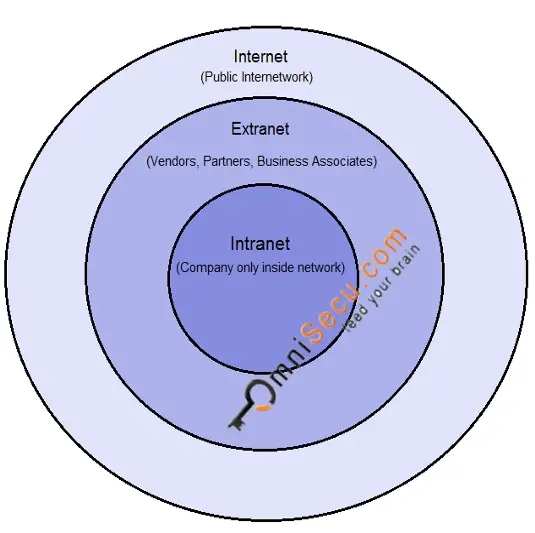Internetworks, Internet, Intranet and Extranet
Internetworks
Before discussing about the terms internet, intranet and extranet, we need to discuss the term Internetwork.
An internetwork can be defined as two or more computer networks (typically Local Area Networks LAN) which are connected together, using Network Routers.
Each network in an Internetwork has its own Network Address, which is different from other networks in the Internetwork. Network Address is used to identify the networks inside an Internetwork.
Internetwork allows different users at different geographical locations of an organization to share data, resources and to communicate. Modern businesses cannot even function without Internetwork. Internet, Intranet and Extranet are different types of internetwork.
Internet, Intranet and Extranet
Internet: Internet is a worldwide, publicly accessible computer network of interconnected computer networks (internetwork) that transmit data using the standard Internet Protocol (IP). Largest Internetwork in the world is Internet.
The terms World Wide Web (WWW) and Internet are not the same. The Internet is a collection of interconnected computer networks, linked by copper wires, fiber-optic cables, wireless connections, etc. The World Wide Web is one of the services accessible via the Internet, along with various others including email, file sharing, remote administration, video streaming, online gaming etc. World Wide Web (WWW) is a collection of interconnected documents and other resources, linked together by hyperlinks and URLs.

Most of these interconnected documents in World Wide Web (WWW) are created using a markup programming language called HTML (HyperText Markup Language). Even the webpage you are reading now is created using HTML (HyperText Markup Language)

Intranet: An intranet is a private network that is contained within an enterprise. Typical intranet for a business organization consists of many interlinked local area networks (LAN) and use any Wide Area Network (WAN) technology for network connectivity. The main purpose of an intranet is to share company information and computing resources among employees. Intranet is a private Internetwork, which is usually created and maintained by a private organization. The content available inside Intranet are intended only for the members of that organization (usually employees of a company).
Extranet: An extranet can be viewed as part of a company's intranet that is extended to users outside the company like suppliers, vendors, partners, customers, or other business associates.
Extranet is required for normal day-to-day business activities. For example, placing purchase order to registered vendors, billing & invoices, payments related activities, joint venture related activities, product brochures for partners, discounted price lists for partners etc.
